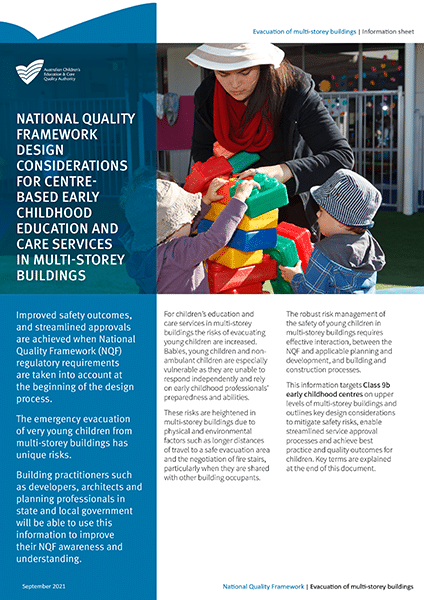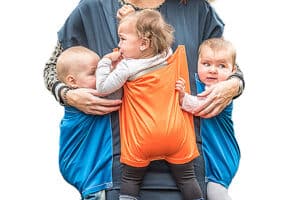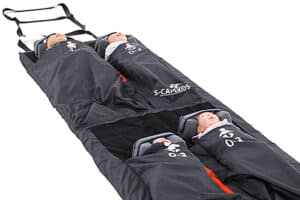
For centre-based early childhood education and care services, providing a safe environment for the babies and children in their care is paramount, both in their everyday operations, and also in emergency situations where an evacuation may be required.
 Safely evacuating infants and children is challenging within any setting – however, the risks and challenges are greatly amplified when the evacuation takes place in a multi-storey building.
Safely evacuating infants and children is challenging within any setting – however, the risks and challenges are greatly amplified when the evacuation takes place in a multi-storey building.
The National Quality Framework (NQF) sets out a range of regulatory requirements specific to Class 9b early childhood centres on upper levels of multi-storey buildings to assist providers operating in such buildings. In this article, we’ll examine the key design considerations and essential emergency evacuation equipment required to mitigate safety risks and achieve better outcomes for children.
National Quality Framework and Service Approvals
 When designing a Class 9b early childhood centre in a multi-storey building, considering the NQF regulatory requirements at the beginning of the design process not only improves safety outcomes but also paves the way for streamlined approvals. Before providers can open their doors, they require a ‘service approval’ from the regulatory authority where the service is located. The service approval is given after works are complete and the building is ready for use, so long as the building is deemed safe and fit for purpose.
When designing a Class 9b early childhood centre in a multi-storey building, considering the NQF regulatory requirements at the beginning of the design process not only improves safety outcomes but also paves the way for streamlined approvals. Before providers can open their doors, they require a ‘service approval’ from the regulatory authority where the service is located. The service approval is given after works are complete and the building is ready for use, so long as the building is deemed safe and fit for purpose.
While documents and certification from local government and third parties are used to inform the decision-making process, under the NQF, the decision to grant a service approval must take into consideration the guiding principles and objectives of the NQF, and the adequacy of the proposed service’s policies and procedures (including emergency and evacuation). In addition, ‘other matters’, such as the level where the service is located, how far the occupants need to travel to get to a safe evacuation area, and whether the design allows for adequate supervision and efficient evacuation in an emergency, must also be considered and deemed acceptable. Depending on the regulatory authority’s view of how these factors have been addressed, a service approval may be granted with conditions, for example, reductions in the number of approved places or increases in the number of educators. If they feel the risks can not be sufficiently mitigated, the authority may refuse to grant the service approval, meaning the operators cannot open for business.
Additional building design considerations for safety
In addition to adhering to all the applicable National Construction Code (NCC) requirements, designers of Class 9b early childhood centres located in a multi-storey building should also address the unique risks by implementing measures such as:
- Additional fire safety systems (e.g. automatic sprinklers) to support the longer travel time from the upper level to an exit
- Suitable design of evacuation stairs, in particular the size, inclusion of child-height handrails and fall barriers
- Location of designated exits, ensuring they are clear and not obstructed
- Design and fit out of high fire risk areas, including kitchens, for example, with the inclusion of smoke compartmentation
- Suitability of alternative evacuation paths, such as lifts and safe, designated assembly points
- Location of equipment used for evacuation and fire safety.
Essential equipment for the safe evacuation of children
A critical element in mitigating risk and supporting building safety standards is to have the necessary emergency evacuation equipment on hand. For Class 9b early childhood centres operating in a multi-storey building, the need to assist large numbers of babies and small children who are unable to independently evacuate, particularly down stairs and over long distances, needs to be considered and carefully planned for. Having a well-drilled escape plan and the right equipment for the task is mandatory. Some of the essential equipment includes:
Evacuation aprons

Evacuation ropes

Evacuation mattress

Evacuation sleds

Final thoughts
Providing a safe environment for children in early childhood centres located on upper levels of multi-storey buildings is challenging. However, with proper consultation of the NQF during the design phase, the addition of building design features that minimise risk and the availability of essential evacuation equipment within your facility, you can ensure the ongoing safety of the children in your care, even when faced with an emergency.

